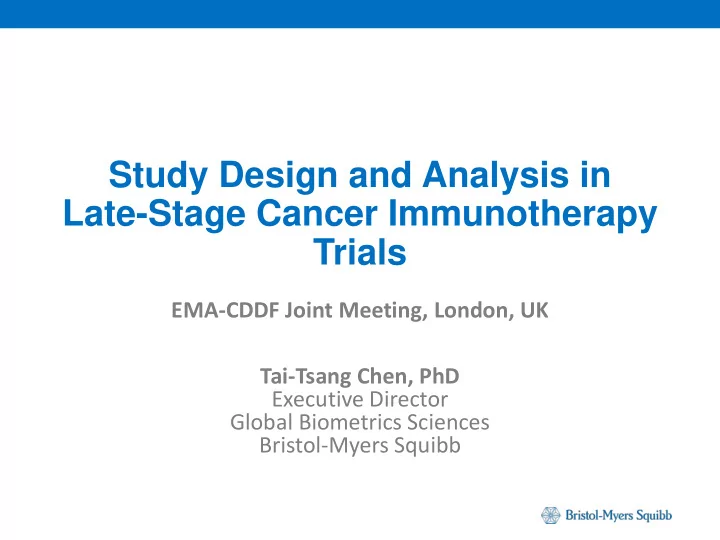

Study Design and Analysis in Late-Stage Cancer Immunotherapy Trials EMA-CDDF Joint Meeting, London, UK Tai-Tsang Chen, PhD Executive Director Global Biometrics Sciences Bristol-Myers Squibb
Disclosure • Employment: currently employed by Bristol-Myers Squibb as Head of Global Biometric Sciences in Medical and Market Access • The views expressed in this presentation are personal based on my experience and do not necessarily reflect the views of Bristol-Myers Squibb
Outline • Challenges in immuno-oncology • Examples of efficacy outcomes in phase III randomized cancer immunotherapy trials • Survival kinetics • Impact caused by study design deviations • Statistical consideration ‒ Study Design ‒ Statistical Analysis • Concluding remarks 3
Challenges in Immuno-Oncology • Biomarkers • Sequence or combinations of immunotherapies • Endpoints • Subgroup • Study Design • Statistical Analysis • Relative effectiveness 4
Examples from Phase III Cancer Immunotherapy Trials 5
Late-Stage Study Design (Time to Event as Primary Endpoint) Conventional Late-Stage Customized Late-Stage Study Design Study Design Exponential decay Non-Exponential decay Proportional hazards Nonproportional hazards Interim analysis with 50% Interim analysis with events >50% events Event-driven Time/event-driven Log-rank test Weighted log-rank test 6
Survival Kinetics 7
Impact Caused by Study Design Deviation 8
Interim Analysis Strategy and Management • Necessity of interim analysis ‒ Interim analysis vs. final analysis only • Timing of interim analysis ‒ Information fraction (% of target events reached) ‒ Early vs. late • Population included in the interim analysis ‒ All patients vs. a subset of patients • Type of interim analysis ‒ Superiority vs. futility
Lessons Learned (Event-Driven vs. Time-Driven Design) • Ipilimumab in front-line metastatic melanoma ‒ Estimated study duration: 3 years • 3 years after study start ‒ ~85% of anticipated number of events ‒ Decreasing event rate ‒ ~84% statistical power • Study continued for another 1.5~2 years for the remaining 15% of number of events • Unblinding occurred with a couple events short of design
Weighted Log-Rank Test • An alternative test procedure to be considered in study design • WLR is more powerful than LR (log-rank) in the presence of delayed clinical effect • Choice of weights depends on ‒ Accumulated knowledge of class of therapy ‒ Timing of delay ‒ Thorough assessment via statistical simulations
Hazard Ratio Post-Separation HR Pre-Separation HR 12
Change in Hazard Ratio
Change in Hazard Ratio (ECOG E4A03)
Median Survival Time 15
Restricted Mean Survival Time 16
Milestone Survival 17
Concluding Remarks • Customized statistical approach needed in cancer immunotherapy research • Unique survival kinetics, i.e., delayed effect and long- term survival need to be built into design and analysis • Time-driven vs. Event-driven study design • Weighted log-rank test is a viable alternative • Median time may not be the optimal summary of treatment effect • Other informative summary statistics: change in hazard ratio, milestone survival or restricted mean survival • Designs using other endpoints possible, such as milestone survival or restricted mean survival time 18
Reference • Fleming, T. R. and Harrington, D. P. (1981). A class of hypothesis tests for one and two samples censored survival data. Comm. Statist. A 10 763–794. • Robert C, Thomas L, Bondarenko I, et al. (2011). Ipilimumab plus dacarbazine for previously untreated metastatic melanoma. N Engl J Med, 364(26):2517–2526. • Tai-Tsang Chen. (2013). Statistical Issues and Challenges in Immuno- Oncology. Journal for Immunotherapy of Cancer , 1:18. • Royston, P and Palmer, MKB. (2013). Restricted mean survival time: an alternative to the hazard ratio for the design and analysis of randomized trials with a time-to-event outcome. BMRM, 13:152. • Uno, H, Claggett, B, Tian, L, et al. (2014). Moving Beyond the Hazard Ratio in Quantifying the Between-Group Difference in Survival Analysis. JCO, 32(22): 2380-2386. • Tai-Tsang Chen. (2015). Milestone Survival: A Potential Intermediate Endpoint for Immune Checkpoint Inhibitors. Journal of the National Cancer Institute , 107(9): djv156. • Rosemarie Mick and Tai-Tsang Chen. (2015). Statistical Challenges in the Design of Late-Stage Cancer Immunotherapy Studies. Cancer Immunology Research , 3(12): 1292-1298. 19
Recommend
More recommend